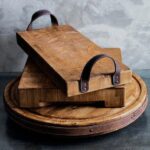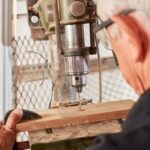Woodworking is a craft that requires precision and finesse, and one of the key factors that can greatly influence the quality of your work is the sharpness of your tools. In particular, Japanese single bevel woodworking tools are known for their exceptional cutting ability and craftsmanship. However, to fully harness the power of these tools, it is crucial to understand the importance of sharpening them properly.
Sharp tools are essential for achieving clean cuts, reducing effort and strain on the user, and ensuring accurate results in woodworking projects. A dull tool not only slows down the process but also increases the risk of accidents due to slipping or snagging. By keeping your Japanese single bevel woodworking tools sharp, you can enhance your efficiency in creating intricate joinery, carving delicate designs, or producing smooth surfaces.
What sets Japanese single bevel woodworking tools apart from other types is their unique design and construction. These tools feature a single beveled edge on one side, allowing for more precise and controlled cuts. The flat backside provides stability and balance during use. Moreover, Japanese steel has a reputation for its exceptional hardness and durability, making it capable of retaining sharpness for longer periods.
In this article, we will delve into the techniques and practices required to sharpen your Japanese single bevel woodworking tools effectively. We will explore the anatomy of these tools to better understand their components and functions.
Additionally, we will discuss essential tools needed for sharpening while providing insights into their purpose and usage. By following our step-by-step guide, you will learn how to bring new life to your collection of woodworking tools, resulting in enhanced craftsmanship and an improved woodworking experience overall.
The Anatomy of Japanese Single Bevel Woodworking Tools
Japanese single bevel woodworking tools are known for their precision and efficiency in woodworking tasks. To fully understand and appreciate these tools, it is important to have a clear understanding of their anatomy. Understanding the different types of Japanese single bevel woodworking tools and their specific parts is crucial for effectively using and maintaining them.
There are several types of Japanese single bevel woodworking tools, each serving a specific purpose. Some common types include the chisel, plane (also known as kanna), and knife. These tools are crafted with precision and designed to make accurate cuts with minimal effort. The unique single bevel design allows for unparalleled control and maneuverability, making them a favorite among woodworkers.
The anatomy of Japanese single bevel woodworking tools consists of various parts, each serving a specific function. For example, the blade is the most important part as it does the actual cutting work. It should be made from high-quality steel to ensure durability and sharpness. The blade is attached to the handle which provides grip and control during use. The tang is another important part that connects the blade to the handle securely.
Other essential parts include the back or flat side of the blade, which serves as a reference surface when sharpening; the hollow or ura, found on certain chisels or planes, which allows for precise cutting; and the hoop or ferrule that secures the handle to the tang.
Understanding these parts will not only help in using these tools effectively but also in properly maintaining them. It is important to regularly clean and oil these tools to prevent rust and maintain their performance. A thorough understanding of their anatomy will also assist in knowing how to properly sharpen them when necessary.
Essential Tools for Sharpening Japanese Single Bevel Woodworking Tools
When it comes to sharpening Japanese single bevel woodworking tools, having the right tools is essential. The following is a comprehensive list of the tools you will need for the sharpening process:
- Sharpening Stone: This is arguably the most important tool for sharpening Japanese single bevel woodworking tools. Choose a high-quality stone that matches the specific grit level you desire. A combination stone with two different grit levels can be ideal for beginners.
- Honing Guide: A honing guide helps ensure consistent and accurate sharpening angles on your tools. It holds the blade securely and keeps it in place as you move it across the stone, resulting in a more precise edge.
- Flattening Stone: Over time, your sharpening stone may develop uneven surfaces due to prolonged use. A flattening stone helps restore the flatness of your sharpening stone, ensuring efficient and effective sharpening.
- Nagura Stone: This small abrasive stone is used to create a slurry on top of the main sharpening stone, which aids in achieving a finer edge during sharpening.
- Tapes or Guides: These can be used to protect the non-beveled surface of your tool or act as a visual guide while maintaining proper angle consistency during sharpening.
- Lubricating Oil or Water: Depending on the type of sharpening stone you are using, lubricating oil or water may be necessary to prevent overheating and keep the abrasive surface clean.
Each tool plays a crucial role in achieving precise and sharp edges on your Japanese single bevel woodworking tools. Understanding their purpose and proper usage will greatly assist you throughout the sharpening process.
It’s worth noting that investing in high-quality tools from reputable manufacturers will determine the overall quality of your results. While it may require initial financial investment, these tools will last longer and provide better performance, making them well worth it in the long run.
Preparing Your Japanese Single Bevel Woodworking Tools for Sharpening
Before diving into the sharpening process, it is essential to properly prepare your Japanese single bevel woodworking tools. Preparing the tools beforehand ensures that they are clean and in optimal condition, allowing for a more effective and efficient sharpening session. Here are step-by-step instructions on how to prepare your tools for sharpening:
- Cleaning: Start by thoroughly cleaning your Japanese single bevel woodworking tools. Remove any dirt, dust, or debris that may have accumulated on them. A soft brush or cloth can be used to gently scrub away any residue. Be mindful of the delicate nature of these tools and avoid using harsh chemicals or abrasive materials that could damage them.
- Inspection: Once cleaned, carefully inspect each tool for any signs of damage or wear. Look out for chips on the cutting edge, cracks in the handle, or any other issues that may affect their performance during sharpening and woodworking tasks. It is crucial to address these concerns before proceeding with the sharpening process.
- Maintenance: After inspection, consider performing necessary maintenance tasks to ensure the longevity of your Japanese single bevel woodworking tools. This may include oiling wooden handles to prevent drying or applying rust-preventive measures to metal components. Taking preventive measures now will help prolong the lifespan of your tools and keep them in optimal condition.
By following these steps to prepare your Japanese single bevel woodworking tools before sharpening, you set yourself up for successful results. A clean and well-maintained tool not only improves overall efficiency during sharpening but also enhances its durability over time.
| Tool | Purpose |
|---|---|
| Soft brush or cloth | To remove dirt, dust, and debris from the tools |
| Inspecting tool (e.g., magnifying glass) | To carefully examine the tools for any damage or wear |
| Lubricant (e.g., oil) | To maintain wooden handles and prevent drying |
| Rust-preventive compound | To protect metal components from rust and corrosion |
Understanding the Sharpening Techniques for Japanese Single Bevel Woodworking Tools
Understanding the correct sharpening techniques for Japanese single bevel woodworking tools is essential to achieving optimal results in your woodworking projects. This section will provide an in-depth explanation of the proper angle and pressure required for sharpening, as well as differentiate between various sharpening methods.
Correct Angle and Pressure
When sharpening Japanese single bevel woodworking tools, it is important to maintain a consistent angle throughout the process. The ideal angle can vary depending on the specific tool, but generally ranges between 20 to 30 degrees. A lower angle provides a sharper edge but may sacrifice durability, while a higher angle offers increased durability but may not be as sharp. It is recommended to start with a slightly higher angle and gradually decrease it until the desired sharpness is achieved.
Applying the right amount of pressure during sharpening is crucial. Too much pressure can damage the blade or result in an uneven edge, while too little pressure may yield unsatisfactory results. It is best to apply light and steady pressure, allowing the abrasive material to do its job without excessive force.
Honing vs Sharpening Stone
There are two main methods for sharpening Japanese single bevel woodworking tools: honing and using a sharpening stone. Honing involves using a leather strop or honing rod to polish and refine the edge of the tool after initial sharpening. This method helps eliminate any small imperfections left behind by the sharpening process and increases overall sharpness.
Using a sharpening stone, also known as a whetstone, is another effective technique for sharpening these tools. The stone should be soaked in water prior to use, then held at a consistent angle against the blade while applying gentle pressure with back-and-forth motions along its length. This method removes material from the blade through abrasion, resulting in a sharper cutting edge.
It is worth noting that both honing and sharpening stones come in varying grit levels, with higher numbers indicating a finer grit for a smoother finish. Coarser grits are generally used for initial shaping and repair, while finer grits are ideal for achieving a polished edge. Experimenting with different grit levels can help achieve the desired level of sharpness for your woodworking needs.
Understanding these sharpening techniques will empower you to maintain the edge and performance of your Japanese single bevel woodworking tools. By mastering the correct angle and pressure, as well as choosing the appropriate method and grit level, you can ensure that your tools remain sharp and ready for any woodworking task.
Step-by-Step Guide
Sharpening Japanese single bevel woodworking tools may seem daunting at first, but with the right techniques and tools, it can become a rewarding and enjoyable process. In this step-by-step guide, we will walk you through the necessary steps to achieve optimum sharpness for your tools.
1. Prepare Your Workspace:
Before starting the sharpening process, it is essential to set up a clean and organized workspace. Clear any clutter or debris from your workbench and ensure there is ample lighting for better visibility. Gather all the necessary tools for sharpening, including a sharpening stone or honing guide, water or oil lubricant, a flattening plate (if using a water stone), and a cloth for cleaning.
2. Clean and Inspect Your Tools:
Inspect each tool carefully before sharpening to ensure they are in good condition. Remove any dirt, rust, or previous coatings using a mild solvent or steel wool. Pay close attention to the blade edge and make sure it is free from nicks or chips that might affect the sharpening process.
3. Set the Correct Angle:
Japanese single bevel woodworking tools have a specific angle at which they should be sharpened. This angle varies depending on the tool and its intended use. It is crucial to determine the correct angle before beginning the sharpening process. One way to do this is by using an angle guide or honing guide that attaches securely to the blade and helps maintain a consistent angle throughout.
4. Choose Your Sharpening Method:
There are different methods you can choose from when sharpening Japanese single bevel woodworking tools – using a honing guide or sharpening directly on a stone. Both methods have their advantages, so it ultimately comes down to personal preference and skill level. If you are new to sharpening, using a honing guide can help you maintain a more consistent angle, while sharpening directly on a stone allows for greater control and precision.
Remember to lubricate your sharpening stone with water or oil according to the manufacturer’s instructions before starting the sharpening process. Start with a coarse grit stone if your tool is very dull and gradually work your way up to finer grits for a polished edge.
5. Sharpen in Stages:
Begin by positioning the tool on the sharpening stone at the correct angle and apply light pressure. Make long, smooth strokes along the length of the blade, moving from base to tip. Repeat this process several times on each side of the bevel, making sure to maintain a consistent angle.
As you progress through different grit sizes, check the sharpness of your tool regularly by running your finger lightly along the blade edge. If it feels rough or catches on your skin, continue sharpening until you achieve a smooth and refined edge.
6. Finishing Touches:
Once you are satisfied with the sharpness of your tool, it is time for some final touches. Use a finer grit stone or strop to refine and polish the edge even further. A few passes on each side should be sufficient to create a razor-sharp finish.
Remember to wipe off any debris or residue from both the blade and sharpening stone using a cloth after each stage of sharpening. This helps maintain cleanliness and prevents particles from getting trapped between the tool and stone in later stages.
By following these step-by-step instructions, you can achieve professional-level sharpness for your Japanese single bevel woodworking tools. Remember that practice makes perfect, so don’t be discouraged if it takes some time to master this skill. With patience and persistence, you can unlock the full potential of your tools and improve your woodworking craftmanship significantly.
Tips and Tricks for Sharpening Japanese Single Bevel Woodworking Tools
Expert Advice for Overcoming Common Challenges
Sharpening Japanese single bevel woodworking tools can be a challenging task, especially for beginners. However, with some expert advice and a few useful tricks, you can overcome these challenges and achieve exceptional results.
One common challenge faced during the sharpening process is maintaining a consistent angle. It is crucial to maintain a steady hand and keep the blade at the correct angle throughout the entire sharpening process. To ensure this, many experts suggest using a honing guide or jig. These tools help in achieving a precise angle and reduce the chances of errors.
Another challenge is maintaining an even pressure while sharpening the tool. Uneven pressure can result in an uneven edge or even damage the blade. One helpful tip to overcome this challenge is to use your fingers as guides. Place your fingers on either side of the blade, applying equal pressure on both sides as you move along the sharpening stone. This helps distribute the pressure evenly and ensures a consistent edge.
Useful Hacks for Exceptional Results
When it comes to sharpening Japanese single bevel woodworking tools, there are some useful hacks that can greatly improve your results. One such hack is using tape to create a micro-bevel on the tool’s flat side. This micro-bevel allows for easier honing and offers better control over sharpening angles.
Additionally, using a marker on the bevel before sharpening can help identify any inconsistencies or high spots on the blade. Simply color the bevel with a marker before starting, and as you remove material during sharpening, you will be able to see if any areas are not being properly addressed.
Lastly, regularly flattening your sharpening stones is essential for achieving optimal sharpness. Over time, these stones develop small grooves that can affect how effectively they sharpen your tools. By using a flattening stone or diamond plate, you can ensure that your sharpening surface remains flat and allows for consistent sharpening.
By incorporating these expert tips and useful hacks into your sharpening routine, you can overcome common challenges and achieve exceptional results with your Japanese single bevel woodworking tools.
Shortcuts for Efficiency
While sharpening Japanese single bevel woodworking tools require time and patience, there are some shortcuts you can use to improve efficiency without sacrificing quality. One such shortcut is using a strop instead of a sharpening stone for honing. A strop is a leather or fabric strip treated with abrasives that allows for quick touch-ups between sharpening sessions. It helps refine the edge and maintain sharpness without removing much material from the blade.
Another shortcut is prepping multiple tools for sharpening at once. The process of cleaning, flattening, and preparing the tools prior to sharpening can be time-consuming. By prepping multiple tools together, you save time on repetitive steps and maximize efficiency.
Additionally, investing in a high-quality honing guide or jig can significantly speed up the sharpening process. These guides hold the tool securely at the correct angle, ensuring consistent results throughout the entire process. They eliminate the need for constant readjustment and allow you to work efficiently.
With these shortcuts in mind, you can streamline your sharpening routine and achieve exceptional results in less time. However, it’s important to balance efficiency with precision for optimal sharpness of your Japanese single bevel woodworking tools.
Maintaining Sharpness
After successfully sharpening your Japanese single bevel woodworking tools, it’s essential to know how to maintain their sharpness. Proper maintenance will not only prolong the lifespan of your tools but also ensure that they remain effective and efficient for future woodworking projects. This section will provide readers with best practices and guidelines to follow for maintaining the sharpness of their Japanese single bevel woodworking tools.
One of the key aspects of maintaining sharpness is proper storage. After completing your woodworking tasks, it is crucial to clean and store your tools correctly. Make sure to remove any debris or sawdust from the blades by wiping them down with a clean cloth or brush. This step is especially important as it prevents moisture build-up, which can lead to rust or corrosion on the blades.
To protect the sharp edge of your tools, consider investing in protective covers or sheaths specifically designed for Japanese single bevel woodworking tools. These covers will help prevent accidental contact with other objects that could dull or chip the blade. Additionally, storing your tools in a dry and controlled environment will further contribute to maintaining their sharpness.
Regular inspections are also necessary to keep your Japanese single bevel woodworking tools at optimal performance levels. Check for any signs of wear, chipping, or damage on the blade edges. If there are any imperfections or dents, use appropriate sharpening techniques to restore their cutting ability. By addressing these issues promptly, you can prevent further damage and ensure a consistent level of sharpness over time.
Lastly, it’s important to establish a recommended frequency for re-sharpening your Japanese single bevel woodworking tools based on individual use and workload. As a general rule of thumb, it is advisable to sharpen your tools regularly so they retain peak performance. Regular practice will allow you to become more familiar with each tool’s unique characteristics and enhance overall craftsmanship in your woodworking projects.
By following these best practices, you can maintain the sharpness of your Japanese single bevel woodworking tools and continue to achieve exceptional woodworking results. Remember that proper maintenance is key to not only protecting your investment but also optimizing your productivity and craftsmanship as a woodworker. With dedication and attention to detail, you will be able to experience the true power of sharpened Japanese single bevel woodworking tools in all your future projects.
Conclusion
In conclusion, sharpening Japanese single bevel woodworking tools is a crucial aspect of achieving exceptional craftsmanship in woodworking. Through this article, we have explored the significance of sharp tools and the unique features and benefits of Japanese single bevel woodworking tools. We have also provided a comprehensive understanding of the anatomy of these tools, along with a list of essential tools for sharpening.
We have discussed the importance of preparing your Japanese single bevel woodworking tools for sharpening by cleaning and maintaining them properly. Additionally, we have explained the correct angle and pressure required for sharpening, as well as the different sharpening methods available. In our step-by-step guide, we have provided detailed instructions to help you successfully sharpen your Japanese single bevel woodworking tools.
Furthermore, we have shared expert tips and tricks for overcoming common challenges during the sharpening process, ensuring that readers can achieve exceptional results. We have also emphasized the importance of post-sharpening maintenance to maintain tool sharpness over time.
By harnessing the power of sharp Japanese single bevel woodworking tools, woodworkers can significantly enhance their craftsmanship and achieve remarkable results. Regular practice in sharpening these tools will not only improve their longevity but also elevate your overall woodworking skills.
Remember, a sharp tool is not just essential for efficiency in work; it also contributes to safety in woodwork projects. So take the time to regularly sharpen your Japanese single bevel woodworking tools and unlock their full potential in creating exceptional pieces of artistry.
Frequently Asked Questions
How do you sharpen a single bevel Japanese knife?
To sharpen a single bevel Japanese knife, you need to follow a specific process. Begin by first identifying the bevel angle of the knife, which is typically between 10 and 15 degrees. Next, prepare a whetstone or sharpening stone by soaking it in water until fully saturated. Place the stone on a stable surface and orient the blade at an angle that matches its bevel.
Using light pressure, start sliding the knife across the stone in a sweeping motion, maintaining a consistent angle throughout. Repeat this process on both sides of the blade until you achieve the desired sharpness. Lastly, finish with a few light strokes on a leather strop to polish and refine the edge.
Are single bevel knives harder to sharpen?
Sharpening single bevel knives can indeed be more challenging compared to their double bevel counterparts. Single bevel knives have only one side honed to an edge, making them asymmetrical in nature. Due to this characteristic, they require precision during sharpening to maintain their proper profile and cutting performance.
The skill level required to sharpen single bevel knives may be slightly higher as it involves successfully maintaining the correct angle while honing only one side of the blade. However, with practice and patience, anyone can learn how to effectively sharpen these unique knives.
Can you hone a single bevel knife?
Single bevel knives can benefit from regular honing just like any other type of knife. Honing helps align the microscopic teeth on the blade’s edge and straighten any minor imperfections that may develop during use. However, there is one crucial difference when it comes to honing single bevel knives: you should only hone the flat side of the blade, avoiding contact with the angled side known as urasuki or shinogi surface.
By doing so, you ensure that your single bevel knife remains properly aligned while still benefiting from periodic honing maintenance. It’s important to note that honing should not substitute for proper sharpening when the blade becomes dull, as honing only realigns the edge and doesn’t remove material to restore sharpness.

Hi everyone! I’m a woodworker and blogger, and this is my woodworking blog. In my blog, I share tips and tricks for woodworkers of all skill levels, as well as project ideas that you can try yourself.





